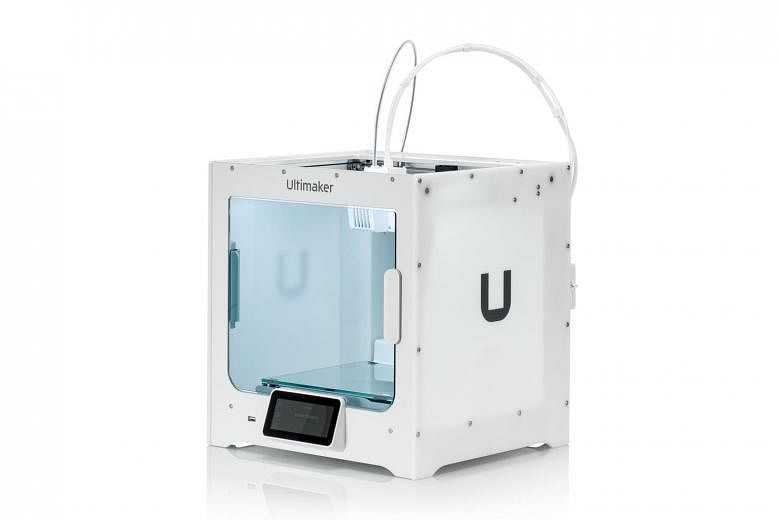Behold the dual-extrusion wonder that is the S3, from Dutch manufacturer Ultimaker. What a single 3D printer can do, the S3, in many cases, can do double.
For example, users can make objects in two colours of the same material in a single print job, or have its two spools loaded with different materials so less time is wasted unloading and reloading should a user wish to switch materials between print jobs. Users can also use two different materials in the same print job, though recommendations have to be followed if users plan to fuse two materials - some plastics cannot bond with others, is one caution.
A couple of weeks before Christmas last year, into my nest of grubby sub-$1,000 hobby printers, the S3 arrived like a glowing white alien cube. That glow is not a metaphor - the translucent white housing lights up from inside not only to let the user see the action on the print bed but also to illuminate it for the internal camera for remote monitoring.
As you would expect for a printer in this price range (the S3 has a $6,527 price tag), it has almost all the bells and whistles. There is the network connectivity through Wifi and Ethernet, that lets users send jobs from a computer to the printer, then control basic functions like pause and also monitor the progress of the job through a video feed.
The heating time of the hot end and build bed is fast, with a total of around five minutes taken for the heating and auto bed-levelling to complete. The S3 is more or less send and forget. It has a run-out sensor to detect when the filament supply has been depleted.
Ultimaker sent me the printer with a set of 3D-printing adhesive sticks from maker Magigoo. When the glue is applied to the 230 mm x 190 mm glass bed (with a vertical build height of 200mm) the user is freed from the need to print brims or rafts, the time-consuming and messy add-ons that help projects stick to the bed. The sticks really work, though in a couple of larger prints, I used brims just to be safe, out of habit I guess.
Through the 0.4mm nozzle, I tested the S3 with PLA filament, the most common plastic material used in the 3D printing community. The print quality was superb, whether it was in normal 0.2mm layer height mode or in faster, thicker layer-height modes.
I also tested with the semi-flexible materials polypropylene and nylon, and these also came out well, though the nylon print was covered in fine hair-like stringing, easily removed with a hot air gun. According to the Ultimaker technical support expert, stringing with flexibles can be avoided by increasing the retraction setting, which I did try and found helpful.
I printed a tall column in black nylon to test the S3's precision and stability in the vertical axis, and also printed parts using both extruders in a single print job. I printed a business card in two colours, with the background in red PLA and the text in transparent PLA. All jobs came out crisp and sharp. The free Ultimaker Cura software lets users tweak dozens of settings, or leave it to work in default mode. It also provides the remote viewing and management interface.
The S3 is aimed at those who simply want to print instead of fiddle with or diagnose the myriad of issues that plague less expensive printers. Its target audience is manufacturers, design shops and schools. To that end, the S3 can also print in technical materials such as glass and carbon fiber composites, as long as the right add-ons are installed.
One of the most bothersome issues with 3D printers is clogging and Ultimaker solves that in two steps. Though it works with any filament in the 2.85mm size, Ultimaker's own filaments come with an NFC tag that, once read by the S3, automatically configures the printer with optimal settings that prevent over- or under-heating. The printer tracks usage and writes the amount consumed back into the tag, so the printer is always up to date on how much material is left no matter how often spools are swopped.
The other way it helps reduce downtime through clogging or other hot-end issues is to combine several hot end functions into a single cartridge that the user can snap in and out. These proprietary "print cores", as Ultimaker calls them, cost $250 and upwards each and also come in various nozzle sizes and material capabilities - one would install the Print Core CC, for example, to enable carbon and glass fiber printing.
That system has its drawbacks - the S3 does not have a hot end that can be disassembled easily should a user wish to, say, unclog a nozzle or replace a heater cartridge - but then it was not designed for that kind of deeper troubleshooting.
The S3 comes with a one-year warranty, with support provided by resellers and partners. It belongs to an elite class of machines that come close to achieving the dream of plug-and-play 3D printing, a goal that today factories and schools desire so newcomers can build projects without the need for a technical expert to hover their shoulder.
FOR
- Works with a wide range of materials, including technical ones like carbon fiber
- Network connectivity for management and monitoring
- Automated bed leveling and filament flow sensor
- Easy to set up and use
AGAINST
- Expensive
- Hardware that is not open to hacking or disassembly, unlike consumer printers
TECH SPECS
PRICE: $ 6,527
TECHNOLOGY: Fused filament fabrication
PRINT HEAD: Dual-extrusion print head with auto-nozzle lifting system and swappable print cores
BUILD VOLUME (XYZ): 230 x 190 x 200 mm
BUILD PLATE: Heated glass build plate (20 - 140 °C)
NOZZLE DIAMETER: 0.4 mm (included); 0.25 mm, 0.6 mm, 0.8 mm (sold seperately)
CONNECTIVITY: Wi-Fi, LAN, USB port
WEIGHT: 14.4 kg
RATING
FEATURES: 4/5
DESIGN: 4.5/5
PERFORMANCE: 4/5
VALUE FOR MONEY: 4/5
OVERALL: 4/5


